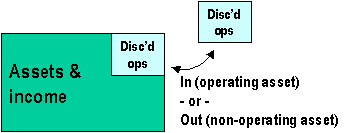Discontinued Operations
Discontinued operations result from the disposal of identifiable segments of a business, including subsidiaries, divisions, and major lines of business. The gain or loss resulting from the disposal is booked on the income statement as an extraordinary item.
Normal costs and expenses prior to the measurement date, i.e., the date that management formalizes the plan for disposal, are not included in the gain or loss but is separately categorized as income or loss from discontinued operations.
Income and assets associated with the discontinued operations are separately identified on the income statement and balance sheet.
Economics of Discontinued Operations
The disposal of a segment is a non-recurring event. Between the measurement date and the time the assets have been shut down or sold (i.e., disposal date), management is in a position to grow the value of the asset. Discontinued operations can generate more of less cash before disposal and realize more or less on disposal based on how they are managed.
Shareholders expect that all assets, regardless of how they are classified, will be managed for maximum value.
Behavioral Impact
Management's focus on an asset will depend on whether the asset and its returns are included or excluded from their reporting. Because discontinued operations are segregated in financial statements, they can easily be segregated from business unit reporting. Whether they should be or not is a matter of accountability.
The decision to dispose of a segment is typically made by corporate managers. Corporate managers are also generally the ones negotiating the sale of the assets. Thus, even if business unit management is expected to maintain an operation to be sold, it is an open question as to whether they get any credit or penalty for the ultimate gain or loss on disposition. How this gets recorded may materially affect how discontinued assets get managed.
Alternative Treatments
Treat as operating asset (default treatment)
If business unit managers are best able to manage the discontinued operations, then those operations assets and the income they generate should be reflected in the EVA of that business as should the eventual gain or loss on sale. This will preserve their accountability for these assets at the business unit level as well as at corporate.

Treat as non-operating asset
If business unit management has little or no effect on the operations of a discontinued operation, its assets should be added back to the business units net assets and income added back to the units net income so that EVA is unaffected by the discontinued operation. The business unit should, however, recognize the gain or loss on sale if and when the operation is sold. In this manner, the foregone operating income or loss that was generated by the asset would be replaced by a capital charge on that assets capitalized gain or loss on disposition.